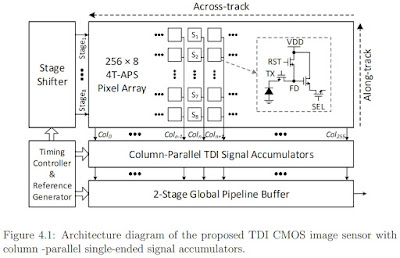Nanyang Technological University, Singapore, publishes a 2015 MSc thesis "Low-power column-parallel ADC for CMOS image sensor by leveraging spatial likelihood in natural scene" by Lifen Liu.
"In this thesis, a new operating method is proposed, which takes into account spatial likelihood in natural scenes. In the proposed method, the MSBs of selected pixel would be predicted before the ADC operation, based on that pixel’s neighbor pixels in the previous row. Because there is strong correlation between consecutive rows in most natural scenes, pre-ADC pixel estimation could save bits in ADC conversion cycles. The total number of ADC conversions would effectively be reduced, resulting in lower power consumption. This method was verified in extensive Matlab simulations, where ADC conversion cycles were reduced by up to 20%-30% for most natural scenes and a saving of up to 29.49% was achieved in switching energy for a 512×512 resolution Lena image."
A 2017 PhD thesis "Low power feature-extraction smart CMOS image sensor design" by Xiangyu Zhang proposes event-based sensor that does not require export of asynchronous pixel addresses to external processor:
"The aim of this work is to design a smart CMOS image sensor that can extract and process motion features on the same chip so as to simplify the entire visual system with minimal computation burden. In order to achieve this ultimate goal, several smart motion-detection image sensors have been developed."
A 2016 PhD thesis "Time-delay-integration CMOS image sensor design for space applications" by Hang Yu proposes:
"(1) A TDI CMOS image sensor was proposed with dynamic pipeline adjacent pixel signal transfer. Following the operation of conventional TDI, the photo signal will be shifted stage by stage and a given photodiode will be reset by the previous-stage photo signal. Meanwhile, this TDI sensor can also configure effective TDI stages for dynamic range and signal-to-noise ratio optimization, as well as the signal transfer direction to compensate for the vibrations. (2) A TDI architecture with single-ended column-parallel signal accumulators was proposed. The TDI operation will be conducted by the off-pixel accumulators, whereby all the photo signals of each TDI stage will be read out after exposure. Accordingly, a 256×8-pixel prototype sensor was designed and fabricated."











No comments:
Post a Comment
All comments are moderated to avoid spam and personal attacks.